

Published by
Princeton Architectural Press
37 East Seventh Street
New York, New York 10003
Visit our website at www.papress.com.
2008, 2015 Princeton Architectural Press
All rights reserved
No part of this book may be used or reproduced in any manner without written permission from the publisher, except in the context of reviews.
Every reasonable attempt has been made to identify owners of copyright. Errors or omissions will be corrected in subsequent editions.
Library of Congress Cataloging-in-Publication Data
Lupton, Ellen, author.
Graphic design : the new basics / Ellen Lupton and Jennifer Cole Phillips. Second Edition, Revised and Expanded.
pages cm
Includes bibliographical references and index.
ISBN 978-1-61689-325-5 (hardcover : alk. paper)
ISBN 978-1-61689-332-3 (paperback : alk. paper)
ISBN 978-1-61689-455-9 (epub, mobi)
1. Graphic arts. I. Phillips, Jennifer C., 1960 author. II. Title.
NC997.L87 2015
741.6dc23
2014046286
For Maryland Institute College of Art
Book Design
Ellen Lupton and Jennifer Cole Phillips
Contributing Faculty
Ken Barber
Kristian Bjrnard
Kimberly Bost
Jeremy Botts
Corinne Botz
Bernard Canniffe
Nancy Froehlich
Brockett Horne
Tal Leming
Ellen Lupton
Al Maskeroni
Sandra Maxa
Ryan McCabe
Abbott Miller
Kiel Mutschelknaus
Jennifer Cole Phillips
James Ravel
Zvezdana Stojmirovic
Nolen Strals
Mike Weikert
Bruce Willen
Yeohyun Ahn
Visiting Artists
Marian Bantjes
Nicholas Blechman
Alicia Cheng
Peter Cho
Malcolm Grear
David Plunkert
C. E. B. Reas
Paul Sahre
Jan van Toorn
Rick Valicenti
For Princeton Architectural Press
Editors
Clare Jacobson and Nicola Brower
Special thanks to
Janet Behning, Erin Cain, Megan Carey, Carina Cha, Andrea Chlad, Tom Cho, Barbara Darko, Benjamin English, Russell Fernandez, Jan Cigliano Hartman, Jan Haux, Mia Johnson, Diane Levinson, Jennifer Lippert, Katharine Myers, Jaime Nelson, Rob Shaeffer, Sara Stemen, Marielle Suba, Kaymar Thomas, Paul Wagner, Joseph Weston, and Janet Wong of Princeton Architectural Press
Kevin C. Lippert, publisher
Contents
Ellen Lupton
Beyond the Basics
Jennifer Cole Phillips
Foreword
Ellen Lupton and Jennifer Cole Phillips
This book is a guide to visual form-making, showing designers how to build richness and complexity around simple relationships. We created the first edition of this book in 2008 because we didnt see anything quite like it for todays students and young designers: a concise, contemporary guide to two-dimensional design. Since its release, Graphic Design: The New Basics has reached an enthusiastic audience around the world. Everywhere we go, we meet educators and young designers who have used the book and learned something from it.
Whats new in this volume? You will find updated and expanded content throughout the book, reflecting new ideas emerging in our classrooms at Maryland Institute College of Art (MICA). The most important addition to this volume, however, is an entirely new opening chapter devoted to formstorming, a term originated by Jennifer Cole Phillips. Formstorming is a set of structured techniques for generating visual solutions to graphic design challenges. We open the book with this chapter in order to plunge our readers directly into the act of visual invention.
As educators with decades of combined experience in graduate and undergraduate teaching, we have witnessed the design world change and change again in response to new technologies. When we were students ourselves in the 1980s, classic books such as Armin Hofmanns Graphic Design Manual (published in 1965) had begun to lose their relevance within the restless and shifting design scene. Postmodernism was on the rise, and abstract design exercises seemed out of step with the interest at that time in appropriation and historicism.
During the 1990s, design educators became caught in the pressure to teach (and learn) software, and many of us struggled to balance technical skills with visual and critical thinking. Form sometimes got lost along the way, as design methodologies moved away from universal visual concepts toward a more anthropological understanding of design as a constantly changing flow of cultural sensibilities.
This book addresses the gap between software and visual thinking. By focusing on form, we have re-embraced the pioneering work of modernist design educators, from Josef Albers and Lszl Moholy-Nagy at the Bauhaus to Armin Hofmann and some of our own great teachers, including Malcolm Grear.
We initiated this project when we noticed that our students were not at ease building concepts abstractly. They were adept at working and reworking pop-culture vocabularies, but they were less comfortable manipulating scale, rhythm, color, hierarchy, grids, and diagrammatic relationships.
This is a book for students and emerging designers, and it is illustrated primarily with student work, produced within graduate and undergraduate design studios. Our school, MICA, has been our laboratory. Numerous faculty and scores of students participated in our brave experiment. The work shown on these pages is varied and diverse, reflecting an organic range of skill levels and sensibilities. Unless otherwise noted, all the student examples were generated in the context of MICAs courses; a few projects originate from schools we visited or where our own graduate alumni are teaching.
Our student contributors come from China, India, Japan, Korea, Puerto Rico, Trinidad, Zimbabwe, a wide range of US states, and many other places. The book was manufactured in China and published with Princeton Architectural Press in New York City. It was thus created in a global context. The work presented within its pages is energized by the diverse backgrounds of its producers, whose creativity is shaped by their cultural identities as well as by their unique life experiences. A common thread that draws all these people together in one place is design.
The majority of student work featured here comes from the course we teach together at MICA, the Graphic Design MFA Studio. Our MFA programs first publishing venture was the book D.I.Y.: Design It Yourself (2006), directed at general readers who want to use design in their own lives. We have published a series of other titles since then, including Indie Publishing (2009), Graphic Design Thinking (2010), and Type on Screen (2014). These books are researched and produced under the aegis of MICAs Center for Design Thinking, an umbrella for organizing the colleges diverse efforts in the area of design education research.
Complementing the student work included in this book are examples from contemporary professional practice that demonstrate visually rich design approaches. Many of the designers featured, including Marian Bantjes, Alicia Cheng, Peter Cho, Malcolm Grear, David Plunkert, C. E. B. Reas, Paul Sahre, Rick Valicenti, and Jan van Toorn, have worked with our students as visiting artists at MICA. Some conducted special workshops, whose results are included in this volume.
Graphic Design: The New Basics lays out the elements of a visual language whose forms are employed by individuals, institutions, and communities that are increasingly connected in a global society. We hope the book will inspire more thought and creativity in the years ahead.
Next page





